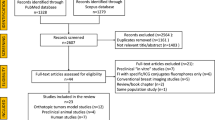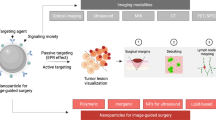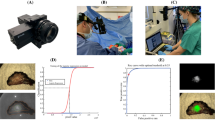Abstract
Purpose
Negative surgical margins (NSMs) have favorable prognostic implications in breast tumor resection surgery. Fluorescence image-guided surgery (FIGS) has the ability to delineate surgical margins in real time, potentially improving the completeness of tumor resection. We have recently developed indocyanine green (ICG)-loaded self-assembled hyaluronic acid (HA) nanoparticles (NanoICG) for solid tumor imaging, which were shown to enhance intraoperative contrast.
Procedures
This study sought to assess the efficacy of NanoICG on completeness of breast tumor resection and post-surgical survival. BALB/c mice bearing iRFP+/luciferase+ 4T1 syngeneic breast tumors were administered NanoICG or ICG, underwent FIGS, and were compared to bright light surgery (BLS) and sham controls.
Results
NanoICG increased the number of complete resections and improved tumor-free survival. This was a product of improved intraoperative contrast enhancement and the identification of a greater number of small, occult lesions than ICG and BLS. Additionally, NanoICG identified chest wall invasion and predicted recurrence in a model of late-stage breast cancer.
Conclusions
NanoICG is an efficacious intraoperative contrast agent and could potentially improve surgical outcomes in breast cancer.






Similar content being viewed by others
References
Miller KD, Siegel RL, Lin CC, Mariotto AB, Kramer JL, Rowland JH, Stein KD, Alteri R, Jemal A (2016) Cancer treatment and survivorship statistics, 2016. CA Cancer J Clin 66:271–289
Nayyar A, Gallagher KK, McGuire KP (2018) Definition and Management of Positive Margins for invasive breast Cancer. Surg Clin North Am 98:761–771
Meric F, Mirza NQ, Vlastos G, Buchholz TA, Kuerer HM, Babiera GV, Singletary SE, Ross MI, Ames FC, Feig BW, Krishnamurthy S, Perkins GH, McNeese M, Strom EA, Valero V, Hunt KK (2003) Positive surgical margins and ipsilateral breast tumor recurrence predict disease-specific survival after breast-conserving therapy. Cancer 97:926–933
Houssami N, Macaskill P, Luke Marinovich M, Morrow M (2014) The association of surgical margins and local recurrence in women with early-stage invasive breast cancer treated with breast-conserving therapy: a meta-analysis. Ann Surg Oncol 21:717–730
Morrow M, Van Zee KJ, Solin LJ et al (2016) Society of Surgical Oncology–American Society for Radiation Oncology–American Society of Clinical Oncology consensus guideline on margins for breast-conserving surgery with whole-breast irradiation in ductal carcinoma in situ. Pract Radiat Oncol 6:287–295
Orosco RK, Tapia VJ, Califano JA, Clary B, Cohen EEW, Kane C, Lippman SM, Messer K, Molinolo A, Murphy JD, Pang J, Sacco A, Tringale KR, Wallace A, Nguyen QT (2018) Positive surgical margins in the 10 Most common solid cancers. Sci Rep 8:5686. https://doi.org/10.1038/s41598-018-23403-5
Morrow M, Jagsi R, Alderman AK, Griggs JJ, Hawley ST, Hamilton AS, Graff JJ, Katz SJ (2009) Surgeon recommendations and receipt of mastectomy for treatment of breast cancer. JAMA 302:1551–1556
Marinovich ML, Azizi L, Macaskill P et al (2016) The Association of Surgical Margins and Local Recurrence in women with ductal carcinoma in situ treated with breast-conserving therapy: a meta-analysis. Ann Surg Oncol 23:3811–3821
Davidson N, Gelber R, Piccart M et al (2010) Overview of the randomized trials of radiotherapy in ductal carcinoma in situ of the breast. J Natl Cancer Inst - Monogr 41:162–177
Donker M, Litière S, Werutsky G, Julien JP, Fentiman IS, Agresti R, Rouanet P, de Lara CT, Bartelink H, Duez N, Rutgers EJ, Bijker N (2013) Breast-conserving treatment with or without radiotherapy in ductal carcinoma in situ: 15-year recurrence rates and outcome after a recurrence, from the EORTC 10853 randomized phase III trial. J Clin Oncol 31:4054–4059
Moran MS, Schnitt SJ, Giuliano AE, Harris JR, Khan SA, Horton J, Klimberg S, Chavez-MacGregor M, Freedman G, Houssami N, Johnson PL, Morrow M, Society of Surgical Oncology., American Society for Radiation Oncology. (2014) Society of Surgical Oncology-American Society for Radiation Oncology consensus guideline on margins for breast-conserving surgery with whole-breast irradiation in stages I and II invasive breast cancer. J Clin Oncol 32:1507–1515
(2018) NCCN Clinical Practice Guidelines in Oncology (NCCN Guidelines® ): Breast Cancer
Smith BD, Jiang J, Shih Y-C et al (2017) Cost and complications of local therapies for early-stage breast Cancer. J Natl Cancer Inst 109:djw178. https://doi.org/10.1093/jnci/djw178
Greenup RA, Camp MS, Taghian AG, Buckley J, Coopey SB, Gadd M, Hughes K, Specht M, Smith BL (2012) Cost comparison of radiation treatment options after lumpectomy for breast Cancer. Ann Surg Oncol 19:3275–3281
Frangioni JV (2008) New technologies for human cancer imaging. J Clin Oncol 26:4012–4021
Olson TP, Harter J, Muñoz A, Mahvi DM, Breslin T (2007) Frozen section analysis for intraoperative margin assessment during breast-conserving surgery results in low rates of re-excision and local recurrence. Ann Surg Oncol 14:2953–2960
Jorns JM, Visscher D, Sabel M, Breslin T, Healy P, Daignaut S, Myers JL, Wu AJ (2012) Intraoperative frozen section analysis of margins in breast conserving surgery significantly decreases reoperative rates: one-year experience at an ambulatory surgical center. Am J Clin Pathol 138:657–669
Chiappa C, Rovera F, Corben AD et al (2013) Surgical margins in breast conservation. Int J Surg 11:S69–S72
Kennedy GT, Okusanya OT, Keating JJ, Heitjan DF, Deshpande C, Litzky LA, Albelda SM, Drebin JA, Nie S, Low PS, Singhal S (2015) The optical biopsy: a novel technique for rapid intraoperative diagnosis of primary pulmonary adenocarcinomas. Ann Surg 262:602–609
Vahrmeijer AL, Hutteman M, van der Vorst JR, van de Velde C, Frangioni JV (2013) Image-guided cancer surgery using near-infrared fluorescence. Nat Rev Clin Oncol 10:507–518
Maloney BW, McClatchy DM, Pogue BW, Paulsen KD, Wells WA, Barth RJ (2018) Review of methods for intraoperative margin detection for breast conserving surgery. J Biomed Opt 23:1–19. https://doi.org/10.1117/1.JBO.23.10.100901
Tummers WS, Warram JM, van den Berg NS, Miller SE, Swijnenburg RJ, Vahrmeijer AL, Rosenthal EL (2018) Recommendations for reporting on emerging optical imaging agents to promote clinical approval. Theranostics 8:5336–5347
Hill TK, Mohs AM (2016) Image-guided tumor surgery: will there be a role for fluorescent nanoparticles? Wiley Interdiscip Rev Nanomedicine Nanobiotechnology 8:498–511
Hong G, Antaris AL, Dai H (2017) Near-infrared fluorophores for biomedical imaging. Nat Biomed Eng 1:0010. https://doi.org/10.1038/s41551-016-0010
Tipirneni KE, Warram JM, Moore LS, Prince AC, de Boer E, Jani AH, Wapnir IL, Liao JC, Bouvet M, Behnke NK, Hawn MT, Poultsides GA, Vahrmeijer AL, Carroll WR, Zinn KR, Rosenthal E (2017) Oncologic procedures amenable to fluorescence-guided surgery. Ann Surg 266:36–47
Tringale KR, Pang J, Nguyen QT (2018) Image-guided surgery in cancer: a strategy to reduce incidence of positive surgical margins. Wiley Interdiscip rev Syst biol med 1–18
Zhang RR, Schroeder AB, Grudzinski JJ, Rosenthal EL, Warram JM, Pinchuk AN, Eliceiri KW, Kuo JS, Weichert JP (2017) Beyond the margins: real-time detection of cancer using targeted fluorophores. Nat Rev Clin Oncol 14:347–364
Olson MT, Ly QP, Mohs AM (2019) Fluorescence guidance in surgical oncology: challenges, opportunities, and translation. Mol Imaging Biol 21:200–218
Schaafsma BE, Mieog JSD, Hutteman M, van der Vorst J, Kuppen PJ, Löwik CW, Frangioni JV, van de Velde C, Vahrmeijer AL (2011) The clinical use of indocyanine green as a near-infrared fluorescent contrast agent for image-guided oncologic surgery. J Surg Oncol 104:323–332
Alander JT, Kaartinen I, Laakso A et al (2012) A review of Indocyanine green fluorescent imaging in surgery. Int J Biomed Imaging 2012:1–26
Wang H, Li X, Tse BW-C et al (2018) Indocyanine green-incorporating nanoparticles for cancer theranostics. Theranostics 8:1227–1242
Payne WM, Svechkarev D, Kyrychenko A, Mohs AM (2018) The role of hydrophobic modification on hyaluronic acid dynamics and self-assembly. Carbohydr Polym 182:132–141
Svechkarev D, Kyrychenko A, Payne WM, Mohs AM (2018) Probing the self-assembly dynamics and internal structure of amphiphilic hyaluronic acid conjugates by fluorescence spectroscopy and molecular dynamics simulations. Soft Matter 14:4762–4771
Mishra A, Behera RK, Behera PK, Mishra BK, Behera GB (2000) Cyanines during the 1990s: a review. Chem Rev 100:1973–2011. https://doi.org/10.1021/cr990402t
Hill TK, Abdulahad A, Kelkar SS, Marini FC, Long TE, Provenzale JM, Mohs AM (2015) Indocyanine green-loaded nanoparticles for image-guided tumor surgery. Bioconjug Chem 26:294–303
Hill TK, Kelkar SS, Wojtynek NE et al (2016) Near infrared fluorescent nanoparticles derived from hyaluronic acid improve tumor contrast for image-guided surgery. Theranostics 6:2314–2328
Qi B, Crawford AJ, Wojtynek NE et al (2018) Indocyanine green loaded hyaluronan-derived nanoparticles for fluorescence-enhanced surgical imaging of pancreatic cancer. Nanomedicine Nanotechnology, Biol Med 14:769–780
Souchek JJ, Wojtynek NE, Holmes MB et al (2018) Optimized hyaluronic acid formulation of near infrared fluorophores for surgical detection of a prostate tumor xenograft. Acta Biomater 75:1–28
Kelkar SS, Hill TK, Marini FC, Mohs AM (2016) Near infrared fluorescent nanoparticles based on hyaluronic acid: self-assembly, optical properties, and cell interaction. Acta Biomater 36:112–121
Bhattacharya DS, Svechkarev D, Souchek JJ, Hill TK, Taylor MA, Natarajan A, Mohs AM (2017) Impact of structurally modifying hyaluronic acid on CD44 interaction. J Mater Chem B 5:8183–8192
Yashuhiro M, Maeda H (1986) Tumor-selective delivery of macromolecular drugs via the EPR effect: background and future prospects. Cancer Res 46:6387–6392
Park JH, Oh N (2014) Endocytosis and exocytosis of nanoparticles in mammalian cells. Int J Nanomedicine 9:51–63
Newton AD, Predina JD, Corbett CJ, Frenzel-Sulyok LG, Xia L, Petersson EJ, Tsourkas A, Nie S, Delikatny EJ, Singhal S (2019) Optimization of second window Indocyanine green for intraoperative near-infrared imaging of thoracic malignancy. J Am Coll Surg 228:188–197
Keating J, Tchou J, Okusanya O, Fisher C, Batiste R, Jiang J, Kennedy G, Nie S, Singhal S (2016) Identification of breast cancer margins using intraoperative near-infrared imaging. J Surg Oncol 113:508–514
Zeh R, Sheikh S, Xia L, Pierce J, Newton A, Predina J, Cho S, Nasrallah M, Singhal S, Dorsey J, Lee JYK (2017) The second window ICG technique demonstrates a broad plateau period for near infrared fluorescence tumor contrast in glioblastoma. PLoS One 12:e0182034. https://doi.org/10.1371/journal.pone.0182034
Koller M, Qiu S-Q, Linssen MD et al (2018) Implementation and benchmarking of a novel analytical framework to clinically evaluate tumor-specific fluorescent tracers. Nat Commun 9:3739
Hoogstins C, Burggraaf JJ, Koller M, Handgraaf H, Boogerd L, van Dam G, Vahrmeijer A, Burggraaf J (2019) Setting standards for reporting and quantification in fluorescence-guided surgery. Mol Imaging Biol 21:11–18
Zhao T, Huang G, Li Y et al (2017) A transistor-like pH nanoprobe for tumour detection and image-guided surgery. Nat Biomed Eng 1:1–8
Prince AC, Jani A, Korb M, Tipirneni KE, Kasten BB, Rosenthal EL, Warram JM (2017) Characterizing the detection threshold for optical imaging in surgical oncology. J Surg Oncol 116:898–906
Prince AC, McGee AS, Siegel H, Rosenthal EL, Behnke NK, Warram JM (2018) Evaluation of fluorescence-guided surgery agents in a murine model of soft tissue fibrosarcoma. J Surg Oncol 117:1179–1187
Yano S, Takehara K, Miwa S, Kishimoto H, Tazawa H, Urata Y, Kagawa S, Bouvet M, Fujiwara T, Hoffman RM (2016) Fluorescence-guided surgery of a highly-metastatic variant of human triple-negative breast cancer targeted with a cancer-specific GFP adenovirus prevents recurrence. Oncotarget 7:75635–75647
Ahmed M, Rubio IT, Klaase JM, Douek M (2015) Surgical treatment of nonpalpable primary invasive and in situ breast cancer. Nat Rev Clin Oncol 12:645–663
Margalit DN, Sreedhara M, Chen Y-H et al (2013) Microinvasive breast cancer: ER, PR, and HER-2/neu status and clinical outcomes after breast-conserving therapy or mastectomy. Ann Surg Oncol 20:811–818
Vieira CC, Mercado CL, Cangiarella JF, Moy L, Toth HK, Guth AA (2010) Microinvasive ductal carcinoma in situ: clinical presentation, imaging features, pathologic findings, and outcome. Eur J Radiol 73:102–107
Tummers QRJG, Hoogstins CES, Gaarenstroom KN et al (2016) Intraoperative imaging of folate receptor alpha positive ovarian and breast cancer using the tumor specific agent EC17. Oncotarget 7:32144–32155
Andreou C, Neuschmelting V, Tschaharganeh DF, Huang CH, Oseledchyk A, Iacono P, Karabeber H, Colen RR, Mannelli L, Lowe SW, Kircher MF (2016) Imaging of liver tumors using surface-enhanced Raman scattering nanoparticles. ACS Nano 10:5015–5026
Kraft JC, Ho RJY (2014) Interactions of Indocyanine green and lipid in enhancing near-infrared fluorescence properties: the basis for near-infrared imaging in vivo. Biochemistry 53:1275–1283
Yanina IY, Tuchin VV, Navolokin NA, Matveeva OV, Bucharskaya AB, Maslyakova GN, Altshuler GB (2012) Fat tissue histological study at indocyanine green-mediated photothermal/photodynamic treatment of the skin in vivo. J Biomed Opt 17:058002. https://doi.org/10.1117/1.JBO.17.5.058002
van Keulen S, van den Berg NS, Nishio N, Birkeland A, Zhou Q, Lu G, Wang HW, Middendorf L, Forouzanfar T, Martin BA, Colevas AD, Rosenthal EL (2019) Rapid, non-invasive fluorescence margin assessment: Optical specimen mapping in oral squamous cell carcinoma. Oral Oncol 88:58–65
Madajewski B, Judy BF, Mouchli A, Kapoor V, Holt D, Wang MD, Nie S, Singhal S (2012) Intraoperative near-infrared imaging of surgical wounds after tumor resections can detect residual disease. Clin Cancer Res 18:5741–5751
Nguyen QT, Tsien RY (2013) Fluorescence-guided surgery with live molecular navigation-a new cutting edge. Nat Rev Cancer 13:653–662
Predina JD, Fedor D, Newton AD et al (2017) Intraoperative molecular imaging: the surgical Oncologist’s north star. Ann Surg 266:e42–e44
Hernot S, van Manen L, Debie P, Mieog JSD, Vahrmeijer AL (2019) Latest developments in molecular tracers for fluorescence image-guided cancer surgery. Lancet Oncol 20:e354–e367
DSouza AV, Lin H, Henderson ER et al (2016) Review of fluorescence guided surgery systems: identification of key performance capabilities beyond indocyanine green imaging. J Biomed Opt 21:080901. https://doi.org/10.1117/1.JBO.21.8.080901
Dontu G, Ince TA (2015) Of mice and women: a comparative tissue biology perspective of breast stem cells and differentiation. J Mammary Gland Biol Neoplasia 20:51–62
Waks AG, Winer EP (2019) Breast Cancer treatment. JAMA 321:288–300. https://doi.org/10.1001/jama.2018.19323
Acknowledgments
This work was supported in part by the National Institutes of Health grants, R01EB019449, P50CA127297, P20GM103480, 1S10RR17846, 1S10RR027940, and P30CA036727 (Fred and Pamela Buffett Cancer Center at UNMC), Department of Defense Breast Cancer Research Program grant (W81XWH-14-1-0567), and the Nebraska Research Initiative. NEW would like to thank the UNMC Graduate Studies Assistantship/Fellowship and the John Borrlson Memorial Scholarship for support. We would also like to thank Megan Holmes, Freshta Baher, Xiaoxiao Qi, and Melissa Malone for technical assistance. Finally, we would like to thank the UNMC Flow Cytometry Core Facilities for assistance with flow sorting analysis, UNMC Small Animal Imaging Core Facility for access to IVIS, UNMC Tissue Sciences Core Facility for sectioning and staining of breast cancer tissue, and UNMC Comparative Medicine Personnel (Kristin Leland and Wendy Schwendeman) for assistance with animal protocol development.
Author information
Authors and Affiliations
Corresponding author
Ethics declarations
Conflict of Interest
The authors have no conflicts of interest to disclose.
Additional information
Publisher’s Note
Springer Nature remains neutral with regard to jurisdictional claims in published maps and institutional affiliations.
Electronic supplementary material
ESM 1
(PDF 2048 kb)
Rights and permissions
About this article
Cite this article
Wojtynek, N.E., Olson, M.T., Bielecki, T.A. et al. Nanoparticle Formulation of Indocyanine Green Improves Image-Guided Surgery in a Murine Model of Breast Cancer. Mol Imaging Biol 22, 891–903 (2020). https://doi.org/10.1007/s11307-019-01462-y
Published:
Issue Date:
DOI: https://doi.org/10.1007/s11307-019-01462-y




